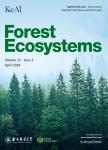Runoff and sediment concentration of different parts of a road in Hyrcanian forests
Runoff and sediment concentration of different parts of a road in Hyrcanian forests作者机构:Department of Forestry Faculty of Natural Resources Sari Agricultural Sciences and Natural Resources UniversitySari 737 Iran Department of Forestry Faculty of Forest Science Gorgan Agricultural Sciences and Natural Resources UniversityGorgan 386 Iran Department of Watershed Management Faculty of Natural Resources Sari Agricultural Sciences and Natural Resources UniversitySari 737 Iran
出 版 物:《Forestry Studies in China》 (中国林学(英文版))
年 卷 期:2013年第15卷第2期
页 面:144-151页
学科分类:0710[理学-生物学] 0830[工学-环境科学与工程(可授工学、理学、农学学位)] 082802[工学-农业水土工程] 090707[农学-水土保持与荒漠化防治] 0907[农学-林学] 08[工学] 0828[工学-农业工程] 0829[工学-林业工程] 09[农学] 0901[农学-作物学] 0902[农学-园艺学] 0713[理学-生态学]
基 金:supported by a grant from the Basij Organizationfor Research Science and Technology in Mazan-daran Province Iran
主 题:runoff soil loss road prism rainfall simulation Hyrcanian forest
摘 要:Road prisms, such as cutslopes, fillslopes and road surfaces, can be important contributors of sediment to streams in forested watersheds. In this study rainfall simulations were carried out on cutslopes, fillslopes, road surfaces and forest grounds in hardwood forests of Lolet and Lat Talar, Iran. Water at intensity of 32.4 mm·h-1 was sprayed from a nozzle onto a square area of 0.48 m2. Runoff was collected by water gauge every 4 min and then runoff and sediment parameters were measured in each plot. Results indicated that on road surfaces, the runoff coefficient was 63.28%. On the cutslopes and fillslopes, the runoff coefficients were 35.14% and 10.23%, respectively. On the forest ground as a control, the runoff coefficient was 5.90%. Runoff volume was 2.73 mL·s^-1 on the road surfaces and 1.52 mL·s^-1 on cutslopes. On fillslopes the runoff volume was 0.44 mL·s^-1 and on the forest ground 0.25 mL·s^-1 The greatest rate of soil loss was found on the cutslope (280.79 g·m-2·h-1). The total soil loss from the cutslopes was two times higher than that from the road surfaces and six times higher than that from the fillslopes. We conclude that cutslopes can be considered the main source of sediments in our study sites, but the function of road surface as a source of runoff generation is more important.



